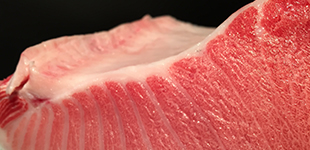While many of our customers are sushi restaurants — customers who demand high-quality products, especially sushi-quality seafood — our reputation for providing consistently superior products and service has attracted a wide range of customers. We regularly deliver to over 12,000 restaurants across North America. Our customers vary — from small neighborhood restaurants to large corporate restaurant chains, from hotels to large casino resort restaurants, from country clubs to cruise ships, and from local Asian-themed food markets to large retail grocery chains.
Mercury is a naturally occurring element in the environment and is also released into the environment from industrial pollution. Mercury that is caused by industrial pollution most commonly accumulates in local streams, rivers and lakes. Mercury can also enter the ocean by way of underwater volcanic activity or steam vents. Nearly all fish and shellfish contain traces of mercury. Mercury builds up more in some fish than others, depending on where they live, what they eat, how long they live, and the overall fat content of the fish. This explains why mercury levels can be highest in larger, older fish such as swordfish and shark. A recent joint study and consumer advisory prepared by FDA and EPA offers the following information and recommendations:
- Certain persons may wish to limit their consumption of certain fish known to contain higher levels of mercury, such as shark, swordfish, king mackerel, or tilefish. (Other varieties of mackerel such as Atlantic, chub, and Spanish mackerel contain significantly lower levels of methylmercury.)
- Taking into consideration that some amount of mercury is naturally occurring in all fish and seafood, FDA has determined that most consumers can safely eat up to 12 ounces (2 average meals) a week of a variety of fish and shellfish that are lower in mercury.
- Five of the most commonly eaten fish that are low in mercury are shrimp, canned light tuna, salmon, pollock, and catfish.
- Other types of tuna, such as bigeye or bluefin, contain slightly more mercury than canned light tuna — but are still well within acceptable levels and are well below the levels commonly found in shark, swordfish, king mackerel, or tilefish.
- One week's normal consumption of fish does not change the level of mercury in the body. FDA suggests that if a consumer eats a lot of higher mercury-type fish one week, they can simply cut back on those types of fish for the next week or two.
- There has never been a published clinical diagnosis in the U.S. conclusively linking health effects to the consumption of mercury in fish.
- FDA provides more information about mercury in fish and shellfish at www.cfsan.fda.gov/seafood1.html
Sourcing and delivering fish and shellfish of the highest quality has always been our mainstay, and we do it better than anyone else! However, we also offer a wide variety of non-seafood items with an Asian focus — frozen products, premium wagyu beef, dry grocery items, fresh produce, and a full line of restaurant tools, supplies, service items and tableware.
Not at this time.
We constantly work with our suppliers to monitor and maintain the quality standards demanded by our customers, and to insure vendors meet the quality standards required by regulatory agencies such as FDA, USDA. There are various regulatory controls in place for all products imported into the U.S., as well as those products originating in the U.S.
All True World Foods facilities in the U.S. are proud HACCP participants. HACCP combines internationally recognized quality standards with a program designed to control safety issues. Under HACCP, we fully integrate safety and quality controls for the products we offer to our customers.
Sashimi and some sushi contain raw ingredients — and as with all raw ingredients, there are certain steps in the production process that are associated with increased risk of microbiological hazards. To address these concerns, proper sanitation and food handling techniques when preparing fish intended for raw consumption are the most crucial tasks at the sushi restaurant and for the suppliers of the sushi restaurant.
In a document titled "Fresh & Frozen Seafood — Selecting & Serving It Safely" dated August 2006, FDA's Center for Food Safety & Applied Nutrition states, "Some species of fish can contain parasites, and freezing will kill any parasites that may be present." Accordingly, FDA's Food Code contains specific freezing requirements and conditions for certain species of fish intended for raw consumption.
The FDA advises that people at greater risk from food borne illness should not eat raw or partially cooked fish or shellfish &em; such as pregnant women, young children, or persons whose immune systems are compromised.
People with generally good health who wish to consume sashimi or sushi should remain alert when identifying reliable or reputable restaurants and retailers, and choose products that are fresh and in good condition.
At True World Foods we are dedicated to providing our customers the highest quality, freshest and tastiest tuna on the market. In keeping with this mission and in accordance with the recommendations of the FDA, the EPA and the US Department of Health & Human Services, we strongly feel that tuna is an important part of a healthy diet. Tuna is rich in heart-healthy omega-3 fatty acid and is also an excellent source of protein.
Fish such as tuna is an important part of a health diet, and has been shown to protect against heart disease and stroke. Studies show that Americans do not consume enough fish. The American Heart Association recommends eating a variety of fish at least twice per week.
Consumers have several varieties of tuna to choose from, and if they are concerned about mercury they can adjust their dining choices. Smaller, shorter-lived species that contain less mercury include ahi or yellowfin and skipjack tunas. Larger, longer-lived species include albacore, bluefin and bigeye tunas.
Bluefin, which has been unfairly targeted by the media of late, is highly regarded by Japanese consumers. The government of Japan — the country which imports and consumes the majority of all bluefin tuna harvested — does not consider the presence of trace amounts of mercury in the fish a condition requiring warnings or limitations on consumption. Bluefin comprises less than 1% of all tuna sold in the U.S., while Japan consumes more than 75% of all bluefin harvested worldwide.
We are a wholesale distributor, providing fresh and frozen seafood and specialty grocery items to numerous types of foodservice and retail establishments.
Our buyers are highly trained, experienced and knowledgeable in buying fish and other seafood products from all over the world — from the U.S., Asia, Europe, Central and South America — to name but a few.
The name depicts our ideal and commitment to operating a "truly good company", a company that is trustworthy and has set for itself a high standard of providing quality products with unparalleled personalized customer service.








